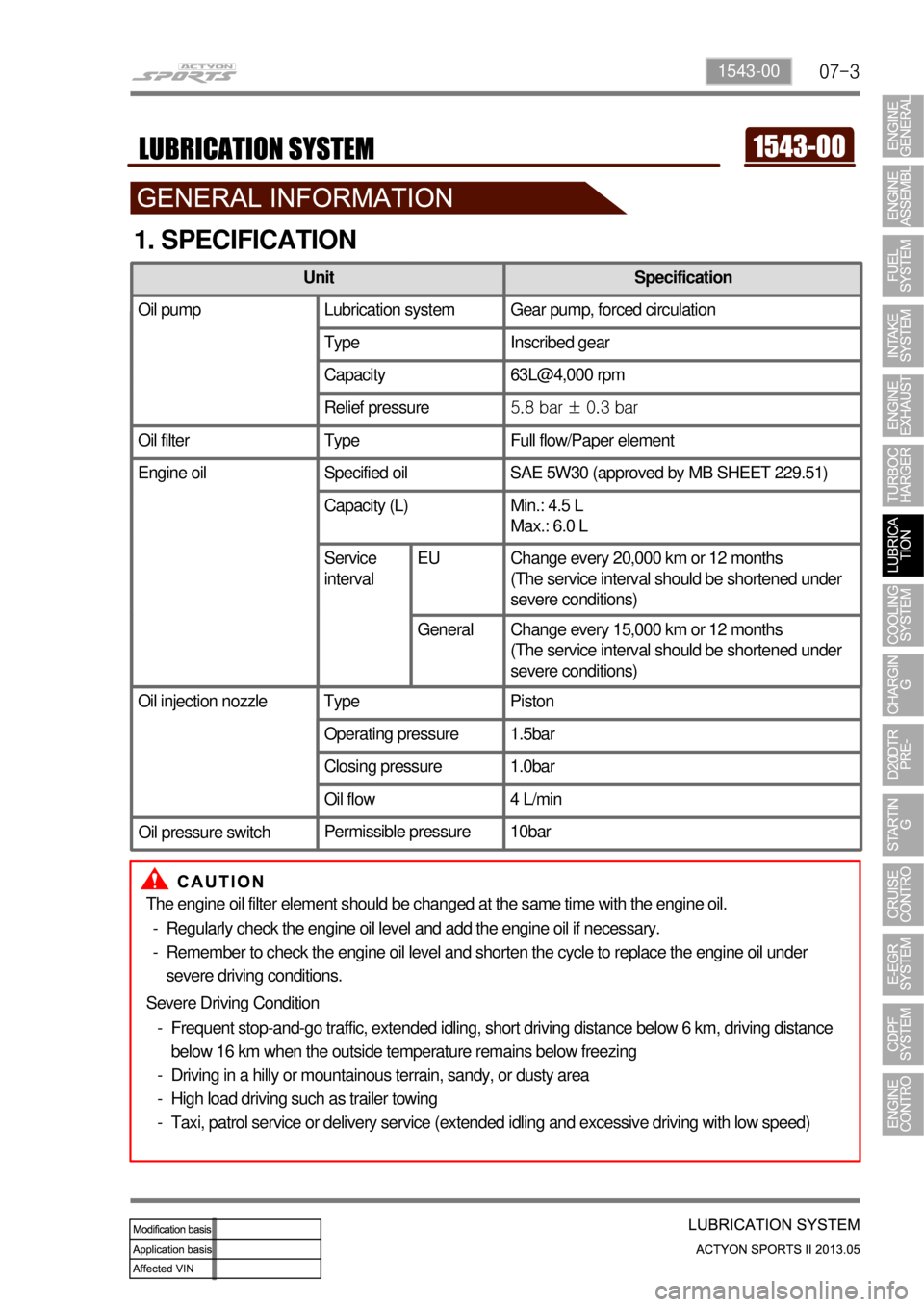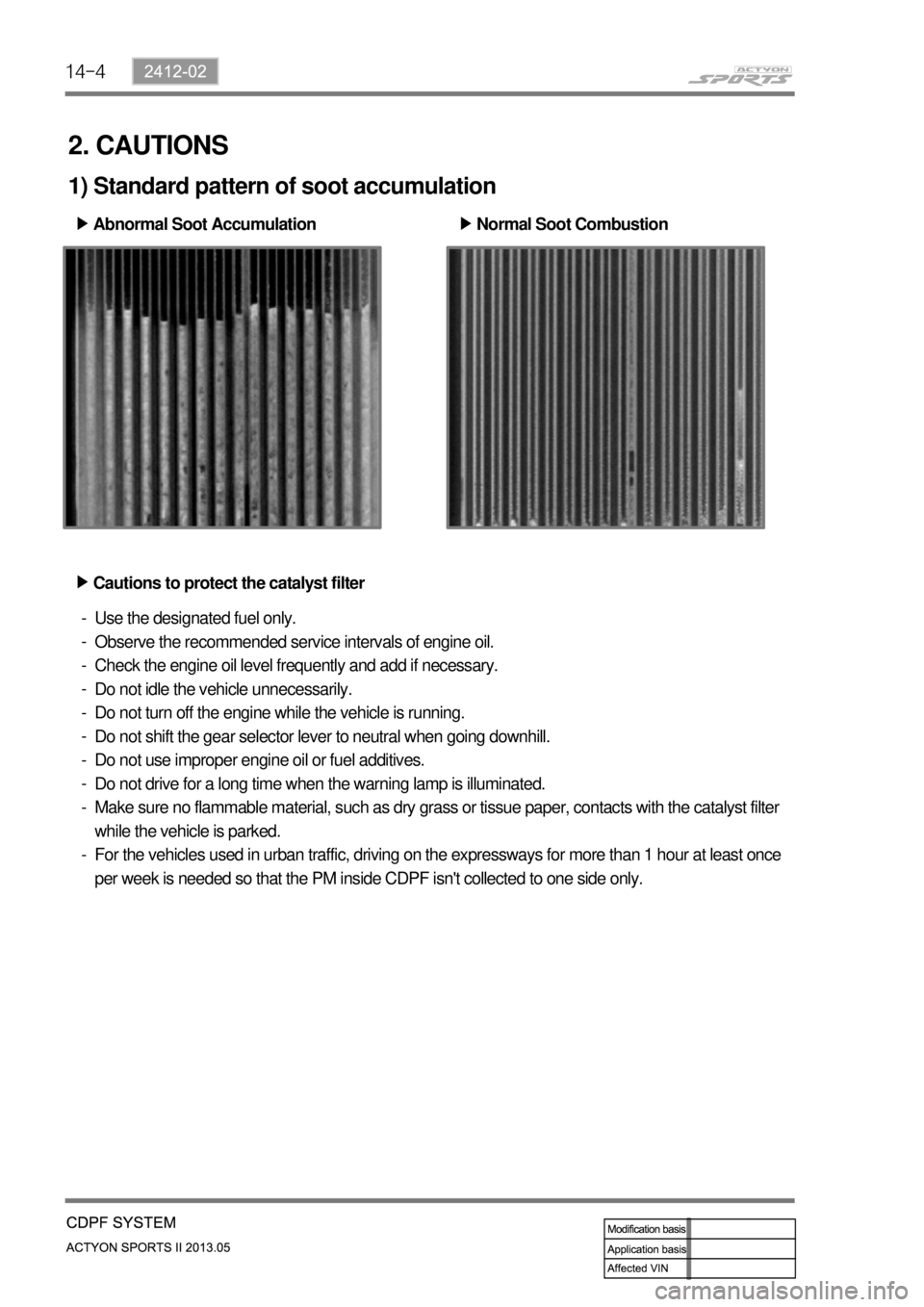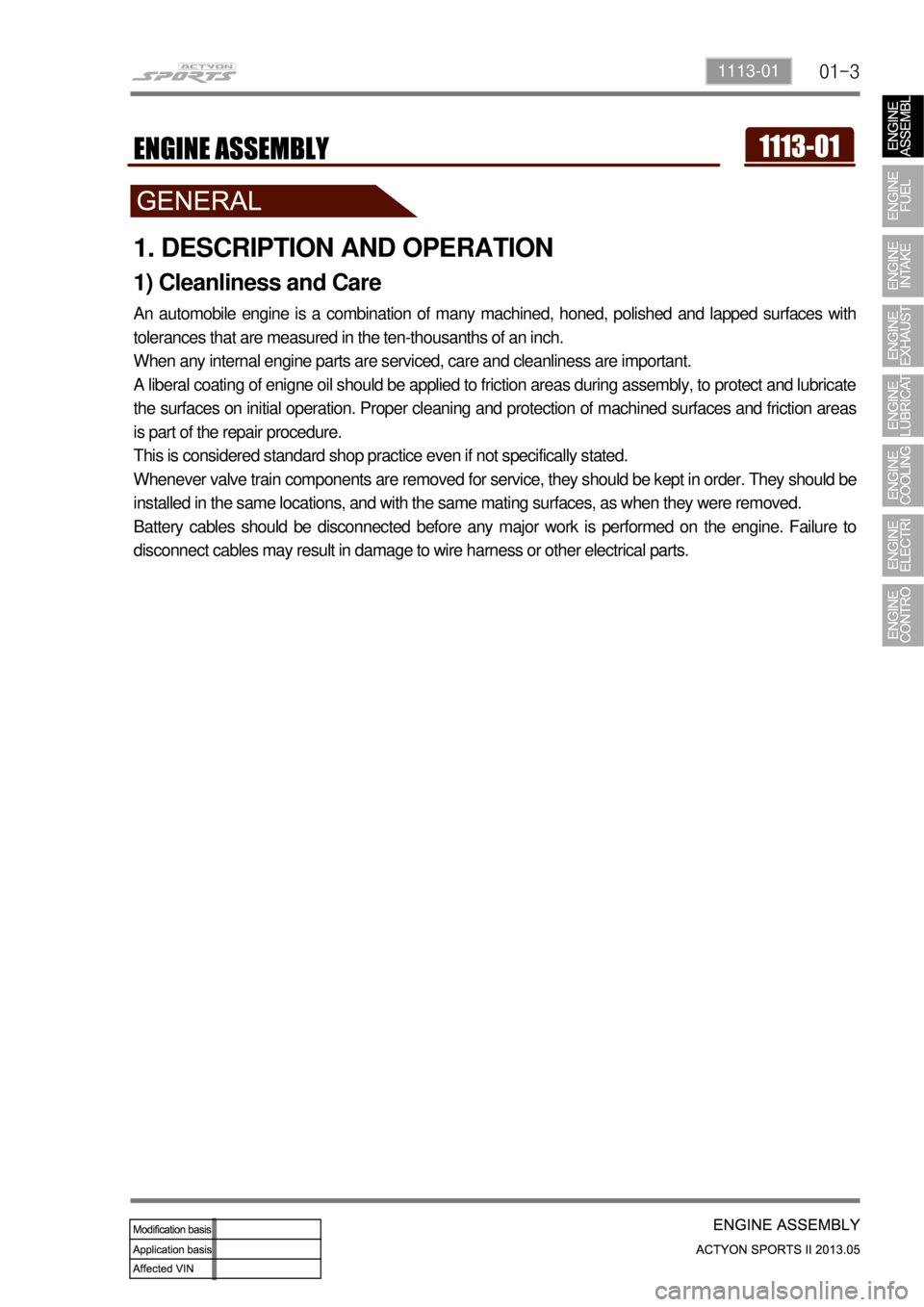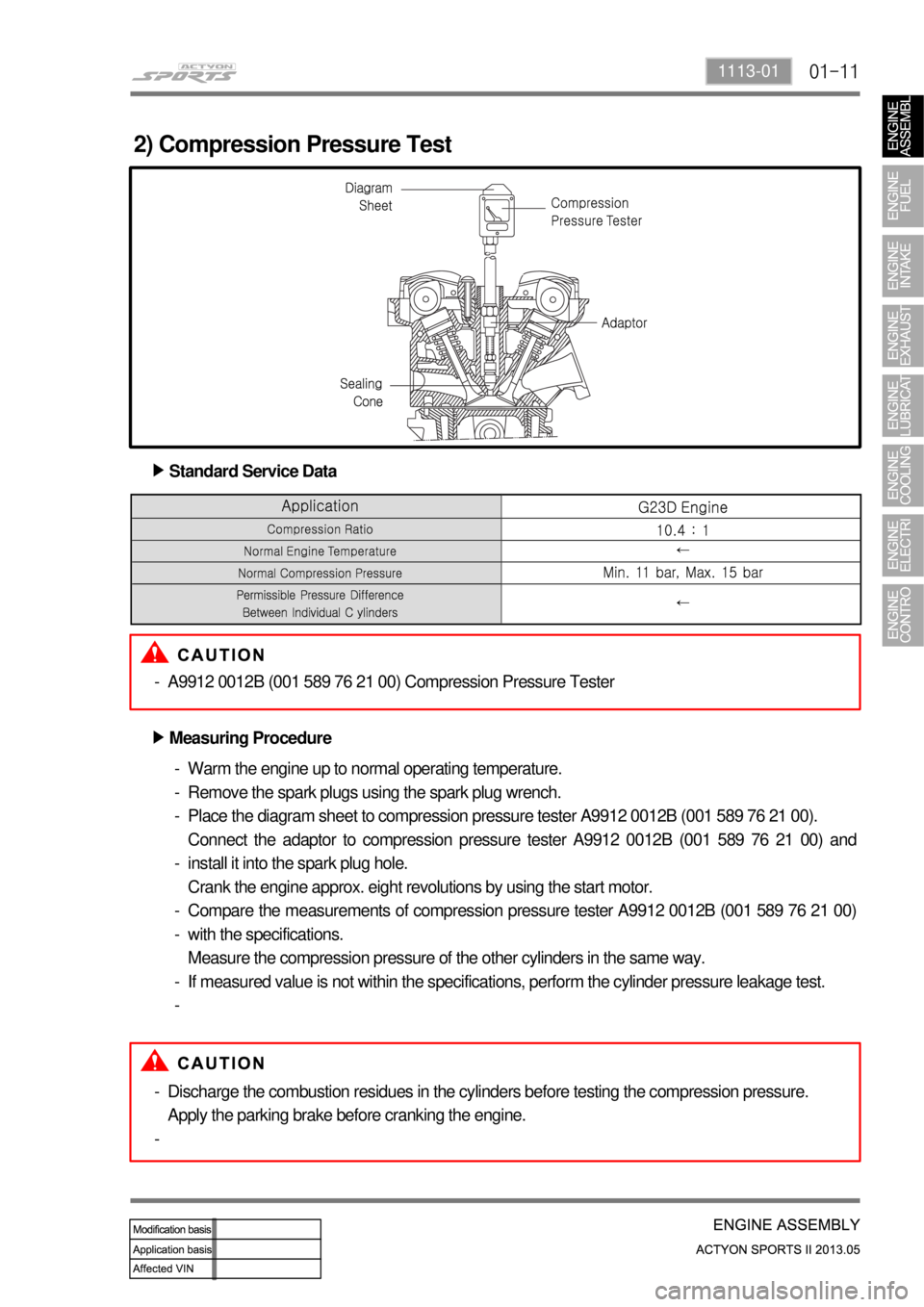service SSANGYONG NEW ACTYON SPORTS 2013 User Guide
[x] Cancel search | Manufacturer: SSANGYONG, Model Year: 2013, Model line: NEW ACTYON SPORTS, Model: SSANGYONG NEW ACTYON SPORTS 2013Pages: 751, PDF Size: 72.63 MB
Page 137 of 751

07-31543-00
1. SPECIFICATION
The engine oil filter element should be changed at the same time with th\
e engine oil.Regularly check the engine oil level and add the engine oil if necessary\
.
Remember to check the engine oil level and shorten the cycle to replace \
the engine oil under
severe driving conditions.
-
-
Severe Driving Condition Frequent stop-and-go traffic, extended idling, short driving distance be\
low 6 km, driving distance
below 16 km when the outside temperature remains below freezing
Driving in a hilly or mountainous terrain, sandy, or dusty area
High load driving such as trailer towing
Taxi, patrol service or delivery service (extended idling and excessive\
driving with low speed)
-
-
-
-
Unit
Specification
Oil pump Lubrication system Gear pump, forced circulation
Type Inscribed gear
Capacity 63 L at 4,000 rpm
Relief pressure 5.8 bar ± 0.3 bar
Oil filter Type Full flow/Paper element
Engine oil Specified oil SAE 5W30 (approved by MB SHEET 229.51)
Capacity (L) Min.: 4.5 L
Max.: 6.0 L
Service interval Change every 15,000 km or 12 months (But, shorten the service interval under severe condition)
Oil injection nozzle Type Piston
Operating pressure 1.5bar
Closing pressure 1.0bar
Oil flow 4 L/min
Permissible pressure 10bar
Unit Specification
Oil pump Lubrication system Gear pump, forced circulation
Type Inscribed gear
Capacity 63L@4,000 rpm
Relief pressure 5.8 bar ± 0.3 bar
Oil filter Type Full flow/Paper element
Engine oil Specified oilSAE 5W30 (approved by MB SHEET 229.51)
Capacity (L) Min.: 4.5 L
Max.: 6.0 L
Service
interval EU Change every 20,000 km or 12 months
(The service interval should be shortened under
severe conditions)
General Change every 15,000 km or 12 months (The service interval should be shortened under
severe conditions)
Oil pressure switch
Page 188 of 751

14-4
2. CAUTIONS
1) Standard pattern of soot accumulation
Abnormal Soot Accumulation ▶
Normal Soot Combustion ▶
Cautions to protect the catalyst filter ▶
Use the designated fuel only.
Observe the recommended service intervals of engine oil.
Check the engine oil level frequently and add if necessary.
Do not idle the vehicle unnecessarily.
Do not turn off the engine while the vehicle is running.
Do not shift the gear selector lever to neutral when going downhill.
Do not use improper engine oil or fuel additives.
Do not drive for a long time when the warning lamp is illuminated.
Make sure no flammable material, such as dry grass or tissue paper, contacts with the catalyst filter
while the vehicle is parked.
For the vehicles used in urban traffic, driving on the expressways for more than 1 hour at least once
per week is needed so that the PM inside CDPF isn't collected to one side only. -
-
-
-
-
-
-
-
-
-
Page 250 of 751

15-50
E. Cautions
Use only specified Engine Oil (approved by MB Sheet 229.51) for CDPF. -
Use only specified engine oil (Low Ash Oil) ▶
The vehicle equipped with CDPF should use specific engine oil to improve the engine performance
and fuel economy, and ensure the service life of CDPF. -
Issue with normal engine oil ▶
Sulfur, one of the contents of engine oil is burned and generates soot that is not regenerated by the
DPF. This remains on the filter as ashes and keeps accumulating. Eventually, this ashes will block
the filter. -
Benefit for specified engine oil ▶
Minimized the sulfur content of engine oil which reduces the service life.
Improved fuel economy and emission level of CO2 with high performance and low viscosity.
Increased service life of engine oil with high resistance to temperature. -
-
-
Problems when using unspecified engine oil ▶
The service life of filter may be reduced by 30% or more by the ashes accumulated on the filter.
The fuel economy may be reduced because of engine rolling resistance, frequent regeneration of
DPF. -
-
These problems are also caused by oil with high sulfur content, such as tax exemption oil and
heating oil, etc. *
Page 252 of 751

01-31113-01
1. DESCRIPTION AND OPERATION
1) Cleanliness and Care
An automobile engine is a combination of many machined, honed, polished and lapped surfaces with
tolerances that are measured in the ten-thousanths of an inch.
When any internal engine parts are serviced, care and cleanliness are important.
A liberal coating of enigne oil should be applied to friction areas during assembly, to protect and lubricate
the surfaces on initial operation. Proper cleaning and protection of machined surfaces and friction areas
is part of the repair procedure.
This is considered standard shop practice even if not specifically stated.
Whenever valve train components are removed for service, they should be kept in order. They should be
installed in the same locations, and with the same mating surfaces, as when they were removed.
Battery cables should be disconnected before any major work is performed on the engine. Failure to
disconnect cables may result in damage to wire harness or other electrical parts.
Page 253 of 751

01-4
2) On-engine Service
Disconnect the negative battery cable before removing or installing any electrical unit, or when a
tool or equipment could easily come in contact with exposed electrical terminals.
Disconnecting this cable will help prevent personal injury and damage to the vehicle. The ignition
must also be in LOCK unless otherwise noted. -
Any time the air cleaner is removed, the intake opening should be covered. This will protect
against accidental entrance of foreign material, which could follow the intake passage into the
cylinder and cause extensive damage when the engine is started. -
Page 260 of 751

01-111113-01
2) Compression Pressure Test
Standard Service Data ▶
A9912 0012B (001 589 76 21 00) Compression Pressure Tester -
Measuring Procedure ▶
Warm the engine up to normal operating temperature.
Remove the spark plugs using the spark plug wrench.
Place the diagram sheet to compression pressure tester A9912 0012B (001 589 76 21 00).
Connect the adaptor to compression pressure tester A9912 0012B (001 589 76 21 00) and
install it into the spark plug hole.
Crank the engine approx. eight revolutions by using the start motor.
Compare the measurements of compression pressure tester A9912 0012B (001 589 76 21 00)
with the specifications.
Measure the compression pressure of the other cylinders in the same way.
If measured value is not within the specifications, perform the cylinder pressure leakage test. -
-
-
-
-
-
-
-
Discharge the combustion residues in the cylinders before testing the compression pressure.
Apply the parking brake before cranking the engine. -
-
Page 287 of 751

06-72112-01
4) Water Pump
The belt-driven centrifugal water pump consists of an impeller, a drive shaft, and a belt pulley.
The impeller is supported by a completely sealed bearing.
The water pump is serviced as an assembly and, therefore, cannot be disassembled.
5) Thermostat
A wax pellet-type thermostat controls the flow of the engine coolant through the engine cooling system.
The thermostat is mounted in the thermostat housing to the front of the cylinder head.
The thermostat stops the flow of the engine coolant from the engine to the radiator to provide faste
r
warm-up, and to regulate the coolant temperature. The thermostat remains closed while the engine
coolant is cold, preventing circulation of the engine coolant through the radiator. At this point, the engine
coolant is allowed to circulate only throughout the heater core to warm it quickly and evenly.
As the engine warms, the thermostat opens. This allows the engine coolant to flow through the radiato
r
wherethe heat is dissipated. This opening and closing of the thermostat permits enough engine coolant
to enter the radiator to keep the engine within proper engine temperature operating limits.
The wax pellet in the thermostat is hermetically sealed in a metal case. The wax element of the
thermostat expands when it is heated and contracts when it is cooled.
As the vehicle is driven and the engine warms, the engine coolant temperature increases. When the
engine coolant reaches a specified temperature, the wax pellet element in the thermostat expands and
exerts pressure against the metal case, forcing the valve open. This allows the engine coolant to flow
through the engine cooling system and cool the engine.
As the wax pellet cools, the contraction allows a spring to close the valve.
The thermostat begins to open at 87°C(188.6 °F) and is fully open at 102°C(215.6°F). The
thermostat closes at 85°C (187°F).
6) Electric Cooling Fan
Keep hands, tools, and clothing away from the engine cooling fans to help prevent personal injury.
This fan is electric and can turn on even when the engine is not running. -
If a fan blade is bent or damaged in any way, no attempt should be made to repair or reuse the
damaged part. A bent or damaged fan assembly should always be replaced with a new one to
prevent possible injury. -
Page 295 of 751

07-6
(2) Cold Cranking Amperage
The cold cranking amperage test is expressed at a battery temperature of -18°C(0°F).
The current rating is the minimum amperage, which must be maintained by the battery for 30 seconds at
the specified temperature, while meeting a minimum voltage requirement of 7.2 volts.
This rating is a measure of cold cranking capacity.
The battery is not designed to last indefinitely. However, with proper care, the battery will provide many
years of service. If the battery tests well, but fails to perform satisfactorily in service for no apparent
reason, the following factors may point to the cause of the trouble:
Vehicle accessories are left on overnight.
Slow average driving speeds are used for short periods.
The vehicle's electrical load is more than the generator output, particularly with the addition o
f
aftermarket equipment.
Defects in the charging system, such as electrical shorts, a slipping generator belt, a faulty generator,
or a faulty voltage regulator.
Battery abuse, including failure to keep the battery cable terminals clean and tight or a loose battery
hold-down clamp.
Mechanical problems in the electrical system, such as shorted or pinched wires. ·
·
·
·
·
·
3) Charging Time Required
The time required to charge a battery will vary depending upon the following factors:
Size of Battery - A Completely discharged large heavy-duty battery required more than twice the
recharging time as a completely discharged small passenger car battery. ▶
<007b008c00940097008c00990088009b009c0099008c00470054004700680047009300960095008e008c00990047009b00900094008c0047009e00900093009300470089008c00470095008c008c008b008c008b0047009b00960047008a008f0088009900
8e008c00470088009500a0004700890088009b009b008c0099>y at -18°C(0°F) than at
27°C(80°F).
When a fast charger is connected to a cold battery, the current accepted by the battery will be very
low at first.
The battery will accept a higher current rate as the battery warms. ▶
Charger Capacity - A charger which can supply only 5 amperes will require a much longer charging
period than a charger that can supply 30 amperes or more. ▶
State-of-Charge - A completely discharged battery requires more than twice as much charge as a
onehalf charged battery.
Because the electrolyte is nearly pure water and a poor conductor in a completely discharged
battery, the current accepted by the battery is very low at first. Later, as the charging current causes
the electrolyte acid content to increase, the charging current will likewise increase. ▶
Page 299 of 751

07-10
9) Starting System
The engine electrical system includes the battery, the ignition, the starter, the generator, and all the
related wiring.
Diagnostic tables will aid in troubleshooting system faults. When a fault is traced to a particula
r
component, refer to that component section of the service manual.
The starting system circuit consists of the battery, the starter motor, the ignition switch, and all the related
electrical wiring.
All of these components are connected electrically.
Page 397 of 751

04-14
3) Fuel Level Gauge
The fuel level gauge displays the resistance value of the float on the fuel sender in the fuel tank through
a pointer. Note that this vehicle doesn't have a service hole for checking the fuel sender connector in the
fuel tank.
The fuel sender and its connector can be checked and replaced only when the fuel tank is removed.
The power supply and resistance value should be measured at the connector in front of the fuel sende
r
(refer to wiring diagram).
When the power supply and output resistance are normal, the float operation by fuel level may be
defective; if so, replace the fuel sender.
Low fuel warning lamp comes on when:
The fuel level drops to 9 L or less. The lamp goes off if the fuel level reaches 9.5 L or more.This table shows the tolerance and resistance value changes by fuel level in normal conditions.
Therefore, the differences that can be occurred by the road conditions and fuel fluctuations are
ignored.